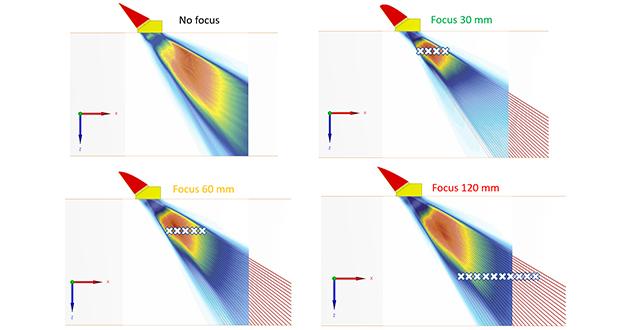07.092021UT inspection - Limits of acoustic focusingCategory "CIVA Software"

Phased-Arrays sensors and systems provide a great flexibility to UT inspectors, as the ultrasonic beam can be adjusted thanks to electronic set-up to increase performances (for detection or sizing) in different situations while using the same probe. For instance, the delay laws enable to steer the beam at different angles (sector scan technique) and/or focus the beam at different depths.
However, ultrasounds remain ultrasounds!
One key rule of acoustics is that you cannot focus beyond the near field distance (governed by the wavelength, frequency and crystal aperture)… And this remains absolutely true with phased-array sensors!
Rather than long explanations and mathematical formulas, let’s use CIVA simulations to illustrate this!
Above, you can see the sound field sector scan coverage generated in a carbon steel block by a linear PA UT probe of 2MHz and 26 mm aperture. The first beam chart on the top left illustrates a sector scan (30° to 60°) without any depth focusing, the max is around 50mm depth corresponding to the natural focal spot, which corresponds to the limit of the near field. Several focal laws are then successively applied to change the focal depth from 30 mm to 120 mm while keeping the same angular scanning. These focal laws lead to a geometrical focusing of the beam illustrated by the white cross, but as you can observe on the 3rd case, and above all the last case, the actual focus cannot be deeper compared to the geometrical “specification”.
It just takes a few minutes to illustrate this with CIVA, and can avoid many misunderstandings and misuse of PA UT probes and systems!
Feel free to contact us if you need more information about ultrasonic testing with CIVA.
The EXTENDE team.

No comment.